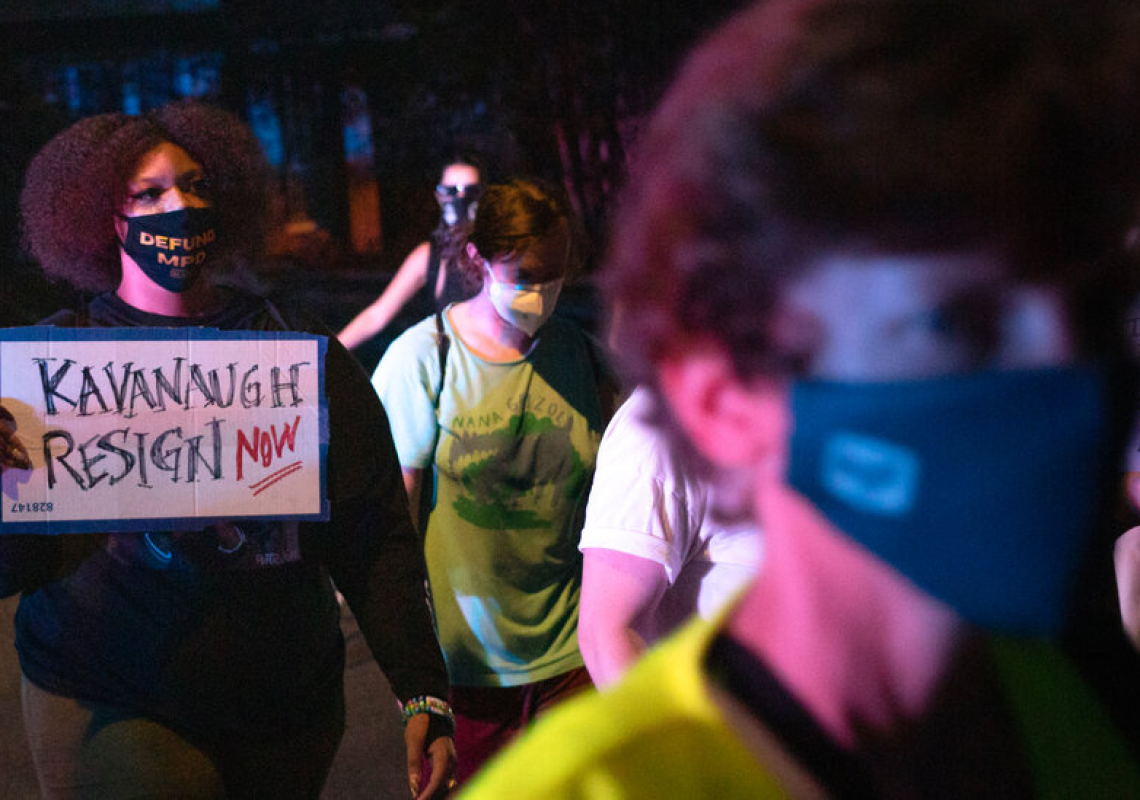Advertisement
Supported by
If the Supreme Court is to reverse course after refusing to block the law in September, at least one conservative justice must change positions. Justice Kavanaugh is the most likely candidate.
Send any friend a story
As a subscriber, you have 10 gift articles to give each month. Anyone can read what you share.
By Adam Liptak
WASHINGTON — Exactly two months after the Supreme Court let Texas effectively outlaw most abortions in the state, it will hear a pair of arguments on Monday that could allow it to reverse course. Much of the attention will be on Justice Brett M. Kavanaugh.
The court’s call for what amounts to a do-over suggests that something is afoot among the justices, said Mary Ziegler, a law professor at Florida State University. “Someone who was not on the fence is probably back on the fence,” she said.
The vote the first time around was 5 to 4, with Chief Justice John G. Roberts Jr. joining the court’s three liberal members in dissent.
If the outcome is to be different, at least one of the members of the conservative majority will have to switch sides. The most likely candidate, legal experts said, is Justice Kavanaugh, who has come to wield enormous power as the justice at the court’s ideological center, shares some of the chief justice’s concerns for protecting the institutional authority of the court and is sensitive to public opinion.
Over his Supreme Court career, which began in 2018 after a bruising and partisan confirmation fight, Justice Kavanaugh has been in the majority 87 percent of the time in divided decisions in argued cases, beating the career records of all justices appointed since 1937.
At his ceremonial swearing-in at the White House, after an introduction by President Donald J. Trump, Justice Kavanaugh made a point of saying that he was a fan of the chief justice. “Chief Justice Roberts is a principled, independent and inspiring leader for the American judiciary,” Justice Kavanaugh said.
He went on to vote with Chief Justice Roberts at a very high rate. In divided decisions in argued cases last term, for instance, the two men voted together 91 percent of the time, the highest rate of agreement among pairs of justices, one tied only by two members of the court’s liberal wing, Justices Stephen G. Breyer and Sonia Sotomayor.
All of this suggests that Justice Kavanaugh’s vote will be the crucial one in the two challenges to the Texas law to be argued on Monday, one from abortion providers and the other from the Biden administration.
“Kavanaugh is probably the most susceptible to changing positions, mostly because I see him as most closely aligned with the chief’s institutional-protection instincts,” said Michael C. Dorf, a law professor at Cornell. “But I don’t think he’s very susceptible.”
The very fact that the court agreed to hear the appeals to be argued Monday on an extraordinarily fast track is an indication that at least one member of the original majority may be in play, said Lawrence Baum, a political scientist at Ohio State.
“The recent surveys showing a decline in approval of the court among the general public seem to have made some justices more sensitive to how people outside the court are reacting to its decisions,” he said.
The Texas law bans abortions after about six weeks and makes no exceptions for pregnancies resulting from incest or rape. In a novel structure intended to insulate the law from federal court review, it bars state officials from enforcing it and instead deputizes private individuals to sue anyone who performs the procedure or “aids and abets” it.
The patient may not be sued, but doctors, staff members at clinics, counselors and people who help pay for the procedure or drive patients to it are all potential defendants. Plaintiffs do not need to live in Texas, have any connection to the abortion or show any injury from it, and they are entitled to at least $10,000 and their legal fees if they win. Defendants who win their cases are not entitled to legal fees.
The Supreme Court’s earlier encounter with the case, culminating in an order issued just before midnight on Sept. 1, left the justices bitterly divided. In an unsigned opinion in that earlier case, the five-justice majority cited “complex and novel” procedural obstacles to blocking the law and stressed that it was not ruling on the constitutionality of the law.
“The negative reactions to the Sept. 1 decision probably surprised some of the justices in the majority,” Professor Baum said, “so that one or more of them felt a need to dispel the perception that they were responding to challenges to the Texas law in a cavalier way that simply reflected their attitudes toward abortion.”
Where does that leave Justice Kavanaugh?
He is, for starters, the member of the court most likely to acknowledge the power of the other side’s argument.
“There are very strong interests on both sides here, which is what makes the case difficult, obviously,” he said last year at an argument over whether employers with religious objections could refuse to provide insurance coverage for contraception.
“There is religious liberty for the Little Sisters of the Poor and others,” he said, referring to an order of nuns that did not want to provide the coverage. “There is the interest in ensuring women’s access to health care and preventive services, which is also a critical interest.” (He later joined a majority opinion ruling in favor of the nuns.)
Dissenting last year from a decision protecting L.G.B.T. workers from employment discrimination, Justice Kavanaugh said that result was required by the text of the relevant statute. “The court has previously stated, and I fully agree, that gay and lesbian Americans ‘cannot be treated as social outcasts or as inferior in dignity and worth,’” he said, quoting an opinion by Justice Anthony M. Kennedy, whom he replaced in 2018.
That last statement, Professor Ziegler said, was part of a pattern suggesting that Justice Kavanaugh is sensitive to how he is seen beyond the court.
“There’s an effort to distance himself from the politics of the ruling and to show that he is a sympathetic person and a good man,” she said.
“Kavanaugh does care about his own personal legacy, and he cares about how he’s perceived — and not just by others who are in the conservative legal movement,” she added.
That sometimes makes his fellow conservatives nervous, Professor Dorf said. “The way that the right constructs this is that it’s a kind of weakness or vanity,” he said. “The more sympathetic view is that he wants to be persuasive to a broad swath of informed opinion.”
Justice Kavanaugh had moved easily in elite circles before his confirmation hearings, during which he heatedly denied accusations of sexual misconduct.
Abortion at the Supreme Court. The justices’ upcoming ruling on a Mississippi law could dramatically change abortion access in the U.S., including possibly overturning the landmark Roe v. Wade decision, which established a constitutional right to abortion.
If Roe v. Wade is overturned. Abortion would remain legal in more than half of states, but not in a wide swath of the Midwest and the South. Legislatures in 22 states would almost certainly move to ban or substantially restrict access to abortion.
Who gets abortions in America? The portrait of abortion has changed with society. Today, teenagers are having far fewer abortions. The typical patient is most likely already a mother, poor, unmarried, in her late 20s, has some college education and is very early in pregnancy.
The politics are complicated. Americans are not as neatly divided on abortion as politicians and activists. Overall, 26 percent of voters hold a different view on abortion than the presidential candidate they supported in 2020, one poll found.
Abortion pills. The F.D.A. will permanently allow patients to receive abortion pills by mail, broadening access to medication abortion, but many conservative states are likely to mobilize against the decision. In 19 states, telemedicine visits for the pills are already banned.
He taught for a decade at Harvard Law School, for instance, garnering positive evaluations from his students.
At his second hearing, after the accusations against him surfaced, he said Democratic senators had sent him into a kind of exile.
“I love teaching law, but thanks to what some of you on this side of the committee have unleashed, I may never be able to teach again,” he said.
That turned out to be only partly true. Justice Kavanaugh has not taught at Harvard since he joined the court (or at Georgetown or Yale, where he had also taught), but he has offered courses at George Mason University’s Antonin Scalia Law School, which has a conservative reputation.
Liberal activists protested outside Justice Kavanaugh’s home in suburban Washington in September, calling on him to support abortion rights. That move drew criticism from senators of both parties.
“Here’s the thing to understand about Kavanaugh: He wants to be liked and admired,” Ruth Marcus, the author of a book about the justice, wrote in The Washington Post. “Unlike some of his conservative colleagues, he enjoyed being part of, and respected by, the legal establishment.”
Justice Kavanaugh’s questions on Monday may give few hints about where he stands on the Texas law, much less on whether he is prepared to vote to overrule Roe v. Wade. Indeed, the arguments in the Texas case will probably address the fate of the constitutional right to abortion only in passing, if at all. The court will turn to that question in earnest on Dec. 1, when it will hear arguments in a case challenging Mississippi’s 15-week abortion ban.
In that case, the court has been asked to overrule Roe, the 1973 decision that ruled that the Constitution does not allow states to ban abortions before fetal viability, or around 23 or 24 weeks.
By contrast, the questions the court has agreed to decide in the Texas case are procedural ones about whether abortion providers and the federal government can sue to challenge a law written to evade review.
The court will provide live audio, as it now does in all arguments.
“It’s going to be bewildering to the average person,” said Professor Dorf, who filed a friend-of-the-court brief supporting the Justice Department. “The question that this case really poses is the hardest question in a federal-courts course, which is: When does a constitutional right entitle one to a judicial remedy and what kind of judicial remedy?”
Tara Leigh Grove, a law professor at the University of Alabama, said the questions before the court were weighty but technical. But she added that the larger issues in the case cast a shadow.
“Procedure is never just about procedure,” she said. “Jurisdiction is never just about jurisdiction.”
Professor Ziegler agreed, adding that the court’s earlier order in the Texas case was telling.
“As much as Texas’ law was ingenious and as much as there were actual real procedural hurdles there,” she said, “it just beggars belief that if there were another constitutional right at issue the court would have behaved in the same way. So it was definitely about Roe.”
Advertisement






